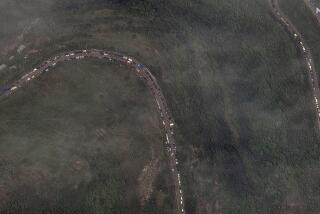A Question of Justice for a People Torn Apart : Soviet Armenians Put Gorbachev on Spot to Correct Errors of the Stalinist Past
- Share via
Soviet leader Mikhail S. Gorbachev’s policy of confronting the legacy of Josef Stalin has revealed past injustices that cannot be ignored.
One such injustice against the Armenians has led to one of the longest series of mass demonstrations ever held in the Soviet Union. Reports reaching the West indicate that during the past month about 30% of the population of Soviet Armenia and 80% of the population of the Nagorno-Karabakh Autonomous Region in neighboring Azerbaijan have participated. Additional tens of thousands have joined their kinsmen in solidarity demonstrations in Paris, New York and Los Angeles.
The Armenians currently seek neither greater autonomy nor independence, but only the reunification of a people separated artificially by a scant 10-mile corridor. Moscow’s response should begin to define its new policy concerning nationalities.
The Soviet state is made up of 15 republics and more than 100 ethnic groups. With regard to the nationalities question, the Soviets have alternated over the years between firmness and reform. Ethnic minorities have launched appeals ranging from requests for greater cultural autonomy, to objections to Russification programs in their territories, to outright demands for independence. Generally the intent of the Soviet central government has been to allow as much cultural autonomy as possible without having that autonomy lead to nationalist expression. The minimal objective of the various nationalities has been to maintain their ethnic identity and their historical territorial integrity. When these objectives are in conflict, headlines are made in the West.
That is what is happening today with Armenian demands that Moscow unite Nagorno-Karabakh with the Soviet Armenian republic. Nagorno-Karabakh (the name “Nagorno” translates from Russian as “mountainous”) has a population of almost 200,000, of whom 80% are Armenian and the rest Azerbaijanis. Karabakh, which forms the eastern extremity of the Armenian plateau, has always been regarded by Armenians as an area of prime historical, cultural and strategic significance. Even when the rest of Armenia had been conquered by the Persian and Turkish empires, Karabakh remained semi-autonomous under the rule of Armenian princes.
At the beginning of the 19th Century Karabakh was annexed by czarist Russia. But the Armenians in the region continued to live in relative peace until 1917, when the Russian Revolution led to a period of chaos in the Caucasus region. In the wake of the temporary Russian retreat from the area in 1918, both Armenia and Azerbaijan declared their independence and Karabakh became a bone of contention between the two states. Despite an intense resistance from the Armenian population, which was demanding unification with the new Armenian republic, Karabakh was claimed and occupied by Azerbaijan, a land with a Turkish Shia Muslim population.
By 1920 the Red Army had entered the Caucasus, extending Soviet control to the region. Azerbaijan renounced its claims on Karabakh and agreed to its unification with Armenia. But Nationalist Turkey under the leadership of Mustafa Kemal was opposed to seeing a larger Armenian state on its eastern borders. Wanting to gain Turkish support in the Soviet struggle against the West, Stalin agreed to an accommodation. The 1921 Treaty of Moscow sanctioned the diminution of Armenia and awarded the disputed territories to Soviet Azerbaijan. In 1923 part of Karabakh was given the status of an autonomous district.
The territorial integrity of Armenia had once again been violated. Today Armenians worldwide are deeply concerned about the fate of their kinsmen in Karabakh. They see in this question an opportunity for justice in a century that has not been kind to their people--a century that began with massacre and genocide at the hands of the Ottoman Turks, resulting in the loss of lands that had been Armenian for more than 2,500 years.
The survivors of the Armenian genocide were exiled to distant lands throughout the globe, including the United States. Stalin’s separation of Karabakh from Armenia must be viewed in this context to understand the breadth and intensity of Armenian actions.
Seeing a regime of genuine reform under Gorbachev, the Armenians of Nagorno-Karabakh, joined by the Armenians of Soviet Armenia and by Armenians on every continent, have stepped forward and are seeking justice.
Gorbachev’s policies of glasnost and perestroika will be put to the test this month. Demonstration leaders have called a temporary moratorium while the Central Committee reconsiders the questions. The challenge for the Soviet proponents of reform is to deal with the artificial separation of the Armenians of Karabakh and to accommodate 80% of the population of an already autonomous territory who simply want to join with their people, thereby ensuring their identity as Armenians.
More to Read
Sign up for Essential California
The most important California stories and recommendations in your inbox every morning.
You may occasionally receive promotional content from the Los Angeles Times.













